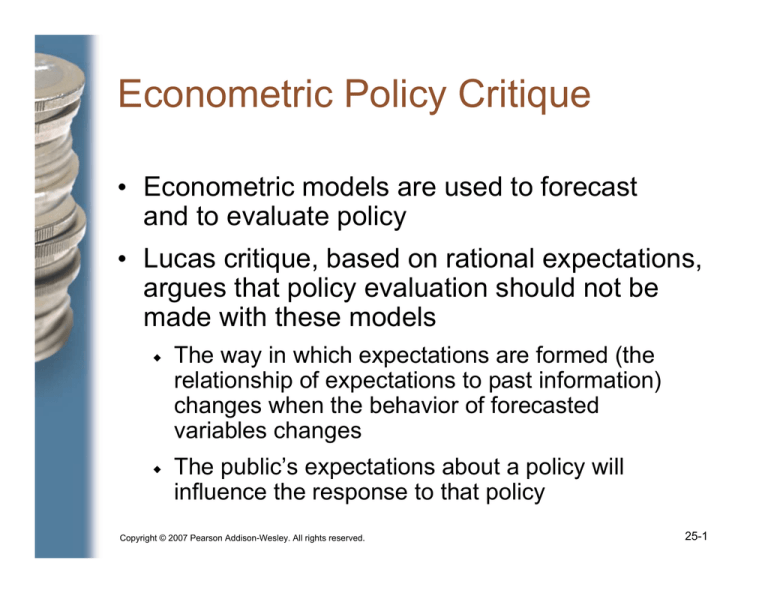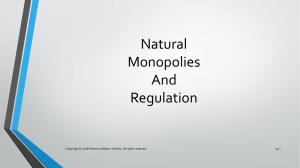
Econometric Policy Critique
• Econometric models are used to forecast
and to evaluate policy
• Lucas critique, based on rational expectations,
argues that policy evaluation should not be
made with these models
The way in which expectations are formed (the
relationship of expectations to past information)
changes when the behavior of forecasted
variables changes
The public’s expectations about a policy will
influence the response to that policy
Copyright © 2007 Pearson Addison-Wesley. All rights reserved.
25-1
New Classical Macroeconomic Model
• All wages and prices are completely flexible
with respect to expected change in the
price level
• Workers try to keep their real wages from
falling when they expect the price level to rise
• Anticipated policy has no effect on aggregate
output and unemployment
• Unanticipated policy does have an effect
• Policy ineffectiveness proposition
Copyright © 2007 Pearson Addison-Wesley. All rights reserved.
25-2
Copyright © 2007 Pearson Addison-Wesley. All rights reserved.
25-3
Copyright © 2007 Pearson Addison-Wesley. All rights reserved.
25-4
Copyright © 2007 Pearson Addison-Wesley. All rights reserved.
25-5
Implications for Policymakers
• Distinction between effects of anticipated and
unanticipated policy actions
• Policymakers must know expectations to know
outcome of the policy
Nearly impossible to find out expectations
People will adjust expectations guessing what the
policymaker will do
• Design policy rules so prices will remain stable
Copyright © 2007 Pearson Addison-Wesley. All rights reserved.
25-6
New Keynesian Model
• Objection to complete wage and
price flexibility
Labor contracts
Reluctance by firms to lower wages
Fixed-price contracts
Menu costs
• Model assumes rational expectations but
wages and prices are sticky
Copyright © 2007 Pearson Addison-Wesley. All rights reserved.
25-7
Copyright © 2007 Pearson Addison-Wesley. All rights reserved.
25-8
Implications for Policymakers
• There may be beneficial effects from
activist stabilization policy
• Designing the policy is not easy because
the effect of anticipated and
unanticipated policy is very different
• Must understand public’s expectations
Copyright © 2007 Pearson Addison-Wesley. All rights reserved.
25-9
Copyright © 2007 Pearson Addison-Wesley. All rights reserved.
25-10
Copyright © 2007 Pearson Addison-Wesley. All rights reserved.
25-11
Copyright © 2007 Pearson Addison-Wesley. All rights reserved.
25-12
Copyright © 2007 Pearson Addison-Wesley. All rights reserved.
25-13
Stabilization Policy
• Traditional
It is possible for an activist policy to stabilize
output fluctuations
• New Classical
Activist stabilization policy aggravates output
fluctuations
• New Keynesian
Anticipated policy does matter to output fluctuations
More uncertainty about the outcome than
Traditional
Copyright © 2007 Pearson Addison-Wesley. All rights reserved.
25-14
Copyright © 2007 Pearson Addison-Wesley. All rights reserved.
25-15
Copyright © 2007 Pearson Addison-Wesley. All rights reserved.
25-16
Copyright © 2007 Pearson Addison-Wesley. All rights reserved.
25-17
Credibility in Fighting Inflation
• Public must expect the policy will be
implemented
• New Classical
Cold turkey
• New Keynesian
More gradual approach
• Actions speak louder than words
Copyright © 2007 Pearson Addison-Wesley. All rights reserved.
25-18
Impact of the
Rational Expectations Revolution
• Expectations formation will change when the
behavior of forecasted variables changes
• Effect of a policy depends critically on the
public’s expectations about that policy
• Empirical evidence on policy ineffectiveness
proposition is mixed
• Credibility is essential to the success of antiinflation policies
• Less fine-tuning and more stability
Copyright © 2007 Pearson Addison-Wesley. All rights reserved.
25-19







